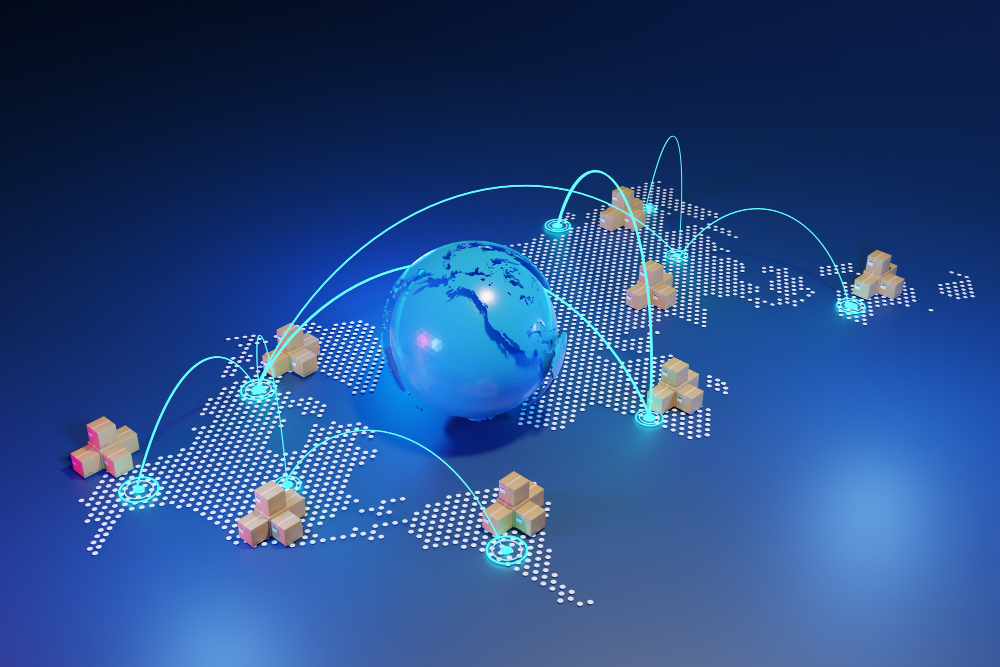Global Supply Chain Networks: Trends to Watch in 2025
Globalisation today rests on Global Supply Chain Networks intricate webs that span continents, industries, and technologies. In this article, we explore why Supply Chain Networks matter more than ever, the trends shaping them, the challenges in managing them, the technologies transforming them, and strategies for resilience.

The conclusion reflects on these insights from the perspective of KnoWerX – An Institute of Supply Chain Management.
What Are Global Supply Chain Networks?
Definition and Core Components
Global Supply Chain Networks refer to interconnected systems of suppliers, manufacturers, logistics providers, distributors, and customers across international borders. They include raw‑material sourcing, production facilities, freight and logistics hubs, warehousing, distribution centers, and retail channels.
Industry Examples
In the automotive industry, parts may come from Asia, with assembly in Europe and distribution globally. In electronics, components from Southeast Asia are shipped to factories in China and final products delivered worldwide. In pharmaceuticals, APIs are sourced globally, formulated in specialized plants, and distributed internationally. These cases highlight the complexity inherent in Global Supply Chain Networks.
Role of Outsourcing and Trade
Outsourcing manufacturing and leveraging international trade agreements help build networks, enabling firms to reduce costs, scale efficiently, access new markets, and diversify risk.
Trends Shaping Global Supply Chains
Sustainability and Green Supply Chains
There is growing pressure on corporations to decarbonize their Global Supply Chain. Companies are pursuing ethical sourcing, carbon neutrality, and circular models such as recycling, refurbishment, and supplier audits to ensure sustainability.
Digital Transformation
Technologies like IoT, AI, machine learning, blockchain, and digital twins are driving the transformation of Global Supply Chain Networks. These tools improve forecasting accuracy, route optimisation, visibility, and transparency across multi‑tier suppliers.
Nearshoring and Regionalisation
Risk‑driven reshoring and nearshoring trends are reshaping Global Supply Chain Networks, as firms in North America and Europe reduce reliance on far‑flung manufacturing hubs and shift to regional models for agility and cost control.
Circular Economy Models
Circular economy practices reverse logistics, remanufacturing, and product life‑cycle traceability are increasingly embedded in Global Supply Chain Networks to meet sustainability goals.
Customer‑Centric Fulfilment
With customers demanding faster, personalised service, Supply Chain Networks are adapting to support last‑mile delivery, real‑time inventory visibility, and omnichannel fulfilment.
Challenges in Managing Global Supply Chain Networks
Geopolitical Instability
Trade wars, tariffs, sanctions, and shifting trade agreements disrupt Global Supply Chain, forcing companies to reroute suppliers or re‑assess sourcing strategies.
Supply Chain Disruptions
Events like the COVID‑19 pandemic, Suez Canal blockage, and natural disasters expose the fragility of Global Supply Chain Networks, causing cascading delays and shortages.
Labour Shortages and Cost Inflation
Labour shortages, rising wages, and inflation drive up operational costs, especially in regions with tight labour markets.
Regulatory and Compliance Issues
Differing regulatory standards across countries on quality, environmental impact, safety, and trade complicate compliance in Global Supply Chain Networks.
Visibility and Transparency
Lack of visibility into multi‑tier suppliers, poor data sharing, and absence of traceability impede risk management across Global Supply Chain Networks.
Technology in Global Supply Chains
Artificial Intelligence & Machine Learning
AI/ML tools enhance demand forecasting, optimise routing, and dynamically manage inventory in Supply Chain Networks, reducing waste and improving responsiveness.
Blockchain
Blockchain solutions provide tamper‑proof, auditable ledgers across Global Supply Chain Networks, boosting trust, traceability, and proof of provenance.
Internet of Things (IoT)
IoT sensors enable real‑time tracking of goods, environmental monitoring, and automated alerts across Global Supply Chain Networks, enhancing control and reducing errors. KnoWerX offers a dedicated Supply Chain Risk and Resiliency Certificate to help professionals manage such risks effectively.
Cloud Computing
Cloud‑based platforms facilitate unified data sharing, collaboration, and analytics across all nodes of Global Supply Chain Networks.
Digital Twins & Simulation
Digital twin models help simulate disruption scenarios and stress‑test Global Supply Chain Networks, allowing proactive contingency planning.
Strategies for Building Resilient Global Supply Chains
Diversification of Supplier Base
Companies strengthen by diversifying suppliers across different countries and regions to avoid single‑point dependencies.
Investment in Risk Management
Establishing early warning systems, scenario planning, and risk mapping helps manage disruptions in Global Supply Chain Networks.
Agile Logistics Planning
Flexible routing, multi‑modal transport options, and adaptive fulfilment strategies enhance agility across Global Supply Chain Networks.
Inventory Buffers & Nearshoring
Strategic safety stock and regional locations help buffer Global Supply Chain Networks against demand volatility and supply interruptions.
Collaboration and Partnerships
Open communication, shared data platforms, and joint initiatives with suppliers and customers create more transparent and resilient Global Supply Chain Networks. KnoWerX’s APICS CSCP Certification empowers professionals to implement such collaboration strategies effectively.
Why Understanding Global Supply Chain Networks Is Crucial Today
- Competitive Advantage: In a globalised economy, a deep understanding of Supply Chain Networks enables firms to operate more efficiently, enter markets faster, and innovate.
- Resilience to Disruption: Knowing your network deeply helps anticipate and respond to shocks be they geopolitical, environmental, or logistical.
- Sustainability and Ethics: As regulations and corporate responsibility demands rise, businesses must ensure ethical sourcing and traceability.
- Compliance Across Markets: Understanding how networks span regulatory regimes helps avoid compliance failures and penalties.
- Customer Expectations: Real-time tracking, transparency, and delivery reliability are expectations only a well‑managed Global Supply Chain Network can meet.
Frequently Asked Questions
What are Global Supply Chain Networks?
They are international systems connecting suppliers, manufacturers, logistics firms, and retailers across borders.
Why are they essential today?
They ensure competitiveness, reduce costs, enhance flexibility, and enable rapid response to global disruptions.
How can I gain expertise in Global Supply Chain Networks?
Enroll in the APICS CSCP Certification or Supply Chain Resiliency Certificate at KnoWerX to build core competencies.
Ending Notes: KnoWerX’s Role in Future-Ready Global Supply Chain Networks

At KnoWerX – An Institute of Supply Chain Management, we understand that mastery over Global Supply Chain Networks isn’t just desirable it’s essential. Our certifications, including the APICS CSCP, Supply Chain Planning Certificate, and Procurement Certificate, are crafted to prepare supply chain professionals for today’s complex and volatile business landscape.
Moreover, through our knowledge-rich blog, we consistently share the latest updates, trends, and strategies to help professionals stay ahead. Whether it’s mastering risk, digital tools, or global partnerships, KnoWerX provides the skills to build and lead resilient Global Supply Chain Networks with confidence.
Image Reference: Freepik
Disclaimer: All trademarks, logos, and brand names are the property of their respective owners. All company, product, and service names used in this website are for identification purposes only. Use of these names, trademarks, and brands does not imply endorsement.



